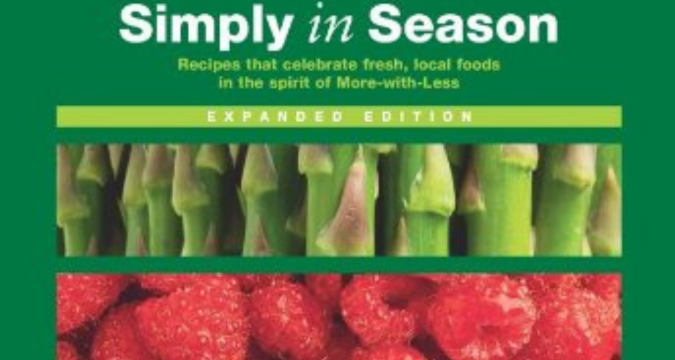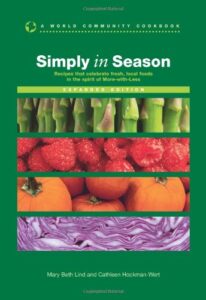Last updated on February 27th, 2024 at 09:08 pm
Simply in Season: Recipes that celebrate fresh, local foods in the spirit of More-with-Less, Mary Beth Lind and Cathleen Hockman-Wert, 2009 (updated 2024: Fishpond.com.au AU$72.97; Amazon.com.au AU$42.97; Amazon.com US$21.94; Amazon.co.uk £21.05)
Only a decade ago I couldn’t get the grapes my pregnant body craved because they were out of season. Yet now I spend perhaps a third of the year refusing to buy my children the grapes they can see in the supermarket because they are grown in the USA and imported to Australia, where we live; we are trying to buy local at least to the extent of buying produce grown in our own country. Though when Australian grown mangoes appear in the shops in Spring, I must conclude that they have travelled thousands of kilometres south to where we are still huddled beneath our thick quilts on frosty nights.
Buy Local, Think Global. It is a slogan that represents the local food movement and is becoming well known as we consider the fossil fuels burned and carbon emissions released when we fly grapes half way across the world so we can have the convenience of eating them year round. Before the long months of nausea in my first pregnancy, when I craved juicy oranges and mandarins and the elusive grapes, I had little awareness of the seasonal nature of produce.
I’d always had some kind of vegetable garden, even when I lived in student housing in my undergraduate years at university, so I was aware of the delight of freshly picked tomatoes versus the store bought variety, but I didn’t think beyond that pleasure. I bought whatever was in the supermarket and cooked mostly the same dishes all year.
In truth, before I had children I rarely bought fruit and was unadventurous in my vegetable purchases. So now that I am thinking global and learning to buy local, I have a whole learning curve ahead of me regarding seasonal food. What do you do in winter when zucchinis (summer squash) and tomatoes are out of season? What about in summer when there are no local sweet potatoes available and when last season’s apples are floury at best? That is where Simply in Season comes in.
The 2009, expanded edition of Simply in Season, by Mary Beth Lind and Cathleen Hockman-Wert, is a wonderful cookbook that doubles as a produce guide. The 300 and some recipes are divided into five colour-coded sections: Spring, Simmer, Autumn (it’s an American publication, so I don’t know why it’s not Fall), Winter and All Seasons.
In addition to the recipes it has a useful glossary, a fruit and vegetable guide with information on how to select, store and prepare a range of produce, and two indexes, one of the recipe titles and a longer on of key ingredients. It also has tidbits and reflections scattered through the recipes, some written by the authors and some reproduced from elsewhere.
The preface tells us that ‘the average food item travels more than a thousand miles before it arrives on our tables’ and ‘each food purchase we make is like a vote for the way we want food to be produced – and for the world in which we want to live’.
Best thing about this book: Besides the obvious (seasonal recipes all organised to make life easy)? The fact that the recipes give both metric and US standard measurements, and in the back it has approximate equivalents of US cups, teaspoons etc to millilitres (because one American cup is not the same as one metric cup, ditto for tablespoons), and even better, substitution recommendations, eg fresh vs dry milk, herbs, and stock, and sugar vs molasses, sour cream vs yoghurt and so on.
Worst thing? I would have liked to see a few more unusual vegetables. Then again it has okra, rutabagas and kohlrabi, none of which I’ve ever cooked with, and I’m probably more likely to use the recipes if the ingredients are things I at least recognise. Also, not many pictures. That’s sad in a recipe book (though I’m sure it keeps the cost down).
Final word: I love what they say in the preface about cooking seasonally meaning adapting recipes to suit local conditions, so I’m going to quote the whole paragraph to conclude:
Simply in Season remains a cookbook filled with delicious recipes. Part of the fun of cooking with the seasons is learning to use what’s locally available, and that often means taking recipes as starting points: a theme on which to playfully improvise rather than a blueprint to follow precisely.
Recipes that I can play with and adapt as I go. Now that’s my kind of cook book.




